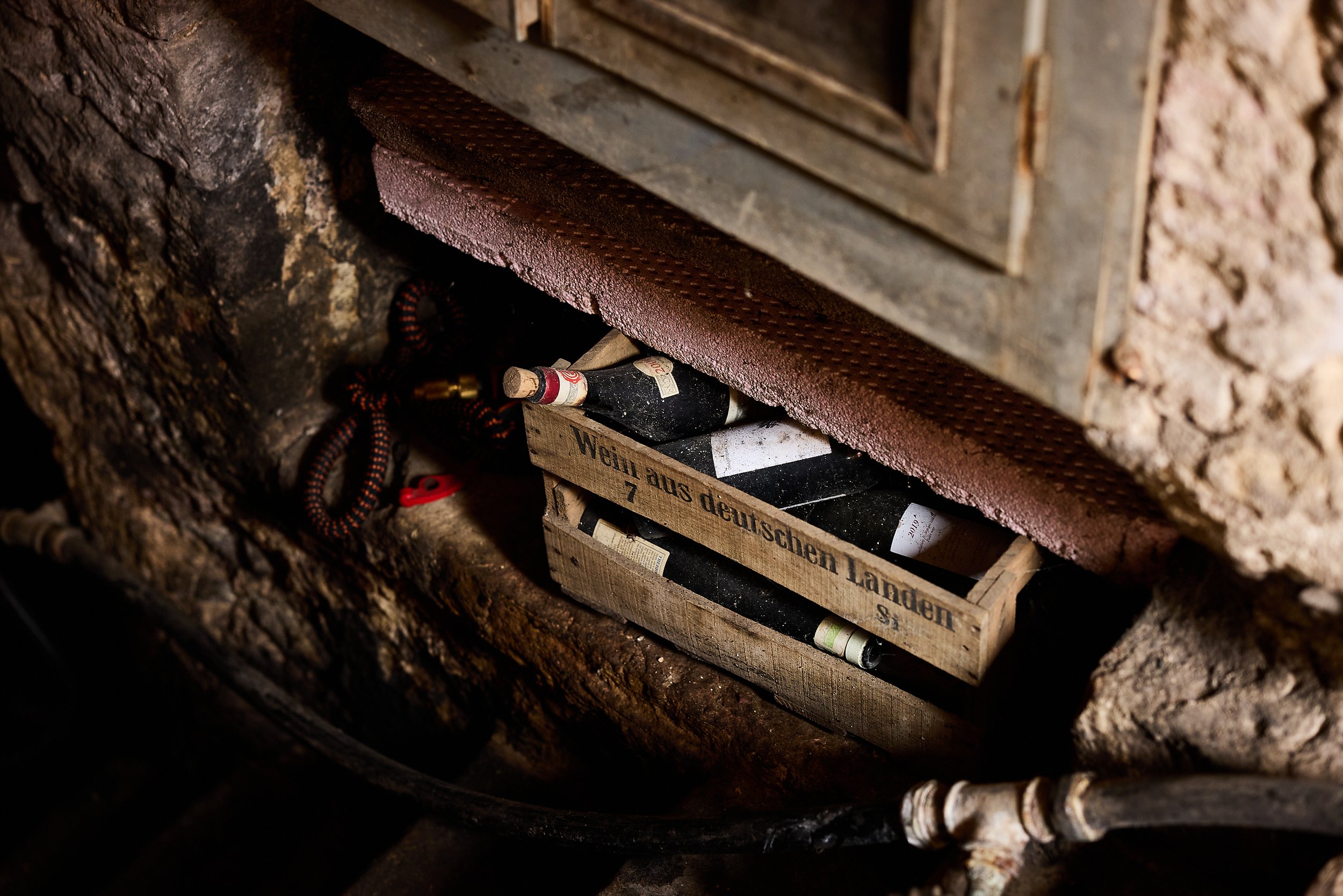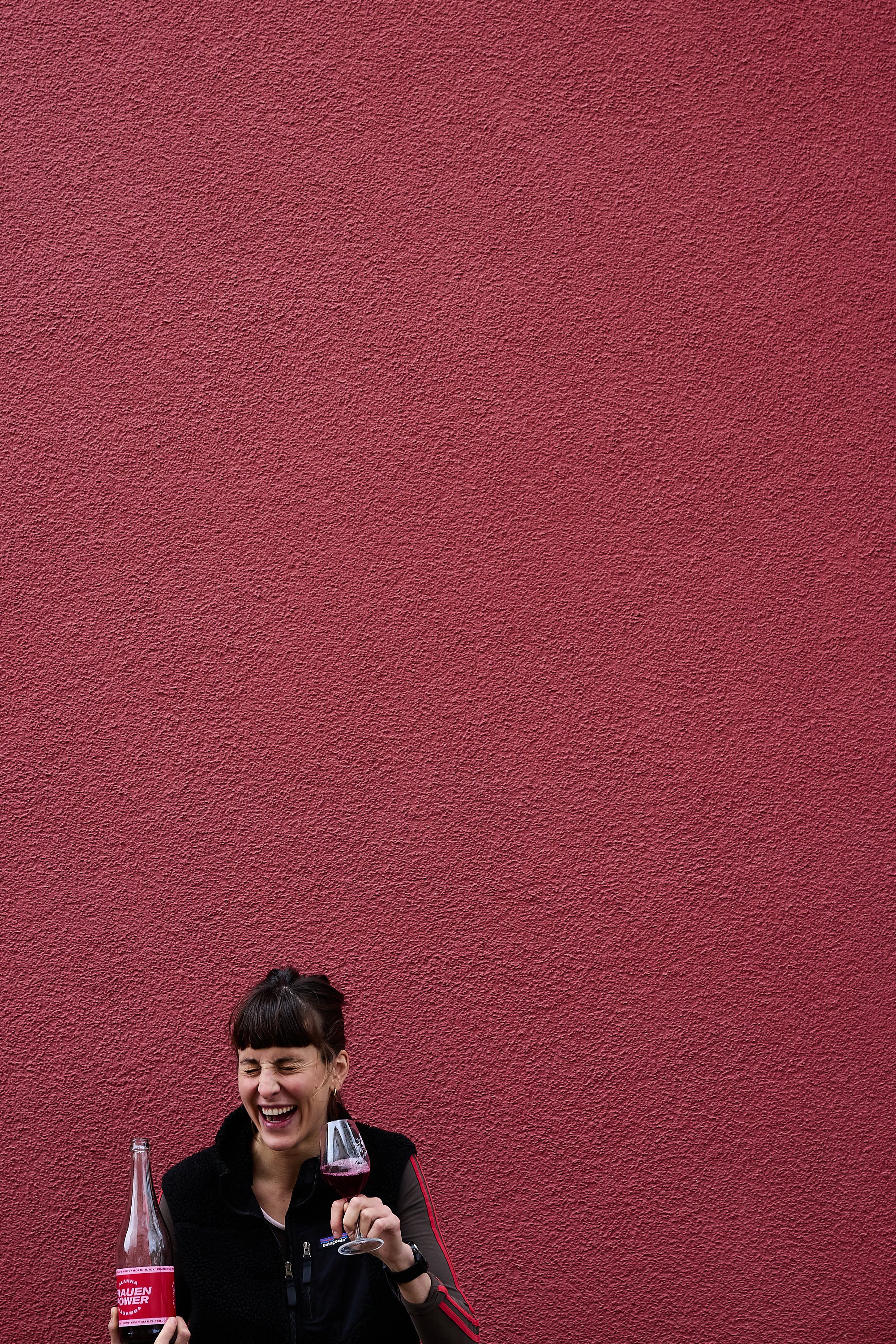Power Fraus and Purple Fizz — In Conversation with Alanna LaGamba of Vin de LaGamba
Dornfelder is a variety so dark, so inky, that it registers more as black than red—and yet it turns into a wine that is the opposite of its colour: light, glossy and a bit unbuttoned. Alanna LaGamba became a winemaker by accident, and this loud-bark-little-dog of a grape is to blame.
Three months out of an art history degree, the Torontonian moved to Berlin with big questions about what to do next, and an even bigger thirst for natural wine. One year later she was working as a sommelier and was invited to Wine Rush, a wine fair in the heart of the city.
“I didn’t really feel like going,” she confesses, but agreed to tag along. At Wine Rush she met Martin Wörner, who had returned to his native Rheinhessen after working with Tom Lubbe at Matassa in France, and took over his family’s vineyards.
Photography by Vivi D’Angelo
“I came here for a week and basically never left,” Alanna says. She joined the 2018 harvest and in 2019 moved to Flonheim. “Everything we do is basically together, but I didn’t want to only be the girlfriend of Marto wines. There’s already so much patriarchy in this industry.”
When Alanna decided to make a wine of her own, she asked Martin for Pinot Noir. With only one small vineyard he’d planted five years earlier that he was excited to finally make wine from, he said no. But he offered her Dornfelder, a grape he didn’t know what to do with.
Dornfelder was widely planted in the 1980s when Bordeaux was hyped. “The colour is pitch black, but it’s ironic because it’s not a big wine,” explains Alanna. With its alcohol maxing out at nine, maybe ten, per cent, it’s never going to be mistaken as a Bordeaux.
Although not her first choice, Alanna had a thought. “Being half Italian, I grew up drinking Lambrusco. So I had the idea to do it German-style.”
Frauen Power’s colour might be dark and stormy, but it smells like bing cherries, the ones that pair so well with boozy chocolate. It’s not sweet, however. It’s dry like blackcurrants that aren’t quite ready to leave their vine. Frauen Power is also a reminder that sparkling wines can do a lot more than toast to special occasions. They dress down just as well as they dress up, accompanying pizza, buttery crackers, or just a balmy afternoon.
At the winery we walk down a handful of stairs into a sandstone cellar. The first barrel archives Alanna’s arrival. “The door was too small for anyone to get into,” she smirks. “So the day I arrived, Martin was like I have a task for you.”
One of the new wines Alanna will soon release has been living in this barrel—a Pinot Noir harvested early for sparkling to retain the grapes’ fresh acidity. They had ten hectares and then last year took over another ten.
Because of its rolling hills, this corner of the region has earned the nickname the Switzerland of Rheinhessen. “It’s a lot of little elevation and almost never flat,” Alanna points out as she drives us to a vineyard.Bottles clink like wind chimes in the basket balancing on my lap as we approach the hill that hosts one of Flonheim’s two trulli. “The Italians who came here in the 60s built them,” she says.
The wind is so loud it joins our conversation. It’s early April and a yellow streak of rapeseed flashes across green fields, advertising the warmer and brighter days to come. Cereals and legumes keep the soon-to-bud vines company. In comparison, their neighbours’ are naked and bare.
“I don’t like it when people take wine so seriously,” she says while opening a bottle of Sekt. “At the end of the day the people who make wine are farmers. Can people relax?” Vin LaGamba’s style might be breezy, a bit ‘grapes gone wild’, but its craft speaks for itself.
***
L. Sasha Gora: What was your gateway to natural wine?
Alanna LaGamba: The funny thing is I wasn’t into wine. When I was at university I bartended at a restaurant called Terroni. Before there was any natural wine in Toronto, randomly they had an orange wine by the glass from Denavolo in Italy that’s pretty natty.
LSG: Did people order it?
AL: Never. I would drink it because it only has so long of a shelf life. But it completely opened up this new world because before I’d been sensitive to sulphur. When I moved to Berlin I worked at a place called JAJA. The owners, Etienne Dodet is French and Julia Giese German, used to have a wine bar in Paris. Etienne had a crazy selection, and I feel like I learned wines through him.
LSG: What was the transition like from pouring wines to making them?
AL: I learned what I loved in wine from drinking wine. When I came here, it was a crazy learning curve because I didn’t know anything about making it, but I knew what I liked.
There are positives and negatives to not being from Germany. I think you always feel a bit like an outsider, but because I’m not from here I’m not bound to convention. The nice thing about tradition is it gives you a guidebook and that can be reassuring. But it’s also nice to create your own.
I think it’s also important to know what you like. Martin and I open bottles, talk about them, analyse them.
LSG: Take them apart to understand how they’re made.
AL: Quite literally, but that’s how you learn. It’s cool because there are not many industries where you create your raw materials. When you think of a carpenter, he’s not growing the tree he gets the wood from. But everything in the bottle is me.
LSG: How do you and Martin influence each other while still distinguishing Marto Wines and Vin LaGamba?
AL: We more or less do everything together, but want to separate our brands. I focus only on sparkling and we make still wines under his brand. We pick each other’s brains about everything, but at the end of the day with the still wines Martin takes the final word and I do with the sparklings.
““Being half Italian, I grew up drinking Lambrusco. So I had the idea to do it German-style.””
LSG: What’s the story behind Frauen Power—the “German-style Lambrusco” that started it all?
AL: Frauen Power is 80 per cent Dornfelder, 20 per cent Silvaner. Because Dornfelder is light, the Silvaner adds body. Martin says it’s the Coca Cola of wine—a complement because he loves Coca Cola!
The name came from a record that Martin’s mom has. She grew up in a small village in the Mosel, but was quite emancipated at a young age. She read a lot of Brigitte when it was a feminist magazine and had this Birgitte vinyl called Frauen Power. I told Martin that my first wine is going to be called Frauen Power, which was also an ode to his mom because she’s a Power Frau and super inspiring.
LSG: Your names and labels—“the most important rosé ever made! Fabulous! Effervescent!”—are as fun and bubbly as your wines. How did they develop?
AL: Pauline from Glow Glow is a good friend and the mastermind behind the labels. When I did the first Frauen Power my inspiration was kind of trashy: the denim Louis Vuitton bags. I wanted it to be Juicy, Fruity, Beautiful, Bold. I wanted it to be loud and in your face.
But then for the Cuvée Royal, I said it has to have cut corners, two lines, a play on the classic Champagne label. I like a little irony.
LSG: I’m curious about your decision to focus on sparkling wines. Why?
AL: Mainly because I love them and always want to drink them. There are lots of great sparkling wines, but I wanted to see what was possible in this region. At the winery we’re not bound by tradition, and it’s the same in the region. You can do what you want and I want to test what we’re capable of. We have beautiful hills and crazy limestone. You can make amazing wine here. It just takes time.
LSG: Your Cuvée Royale takes on tradition. What was your approach to interpreting Sekt?
AL: This we did in 2019 to experiment if we can do Sekt in a completely natural way. The way we do sparkling is risky because we just use fresh juice and so you need to make sure the yeasts are strong. That’s why in Champagne they add sugar and yeast. But the idea felt weird. It’s not like you’re adding chemicals, but it takes away from the vineyard to bottle character.
At the end of harvest we save some Riesling and use it as the sugar. So far it’s worked out, but it’s a bit scary. If the yeasts aren’t strong enough, you could end up with wine in a bottle that isn’t fermenting and would just be sweet. We make sure we use a very strong vineyard—it can’t be stressed.
LSG: You’ve also dabbled in collaborations. What was the idea behind the Powerglow Red you did with Glow Glow: an homage to Gamay without Gamay.
AL: We love Gamay and I think it’s nice when you fall in love with a variety you don’t have. We particularly love Julie Balagany’s Gamay, who passed away last year, and so the idea was to make a similar wine with grapes we grow: Pinot Noir and Portugieser.
LSG: You’ve talked about your dream of becoming the sparkling queen of Rheinhessen, so what are the next steps?
A: I want to always keep Frauen Power and Frauen Power Rosé, but now that we have more vineyards, I want to focus more on varieties. I’ll release two new wines soon. One is a Pinot Noir Sekt.
I did a wine in 2019 called Mehr Frauen ja Bitte—a play on the Atomkraft? Nein Danke label, a Pinot Noir, Riesling and Pinot Blanc. It had a little Dornfelder for the colour, was a direct press white that was a bit rosé, but had zero tannins. I also want to bring it back.
I have many ideas—it just takes time, and I’m quite patient, so that’s okay. The future is to explore the region, the terroir, see what it has to offer and what we can create from it.



































